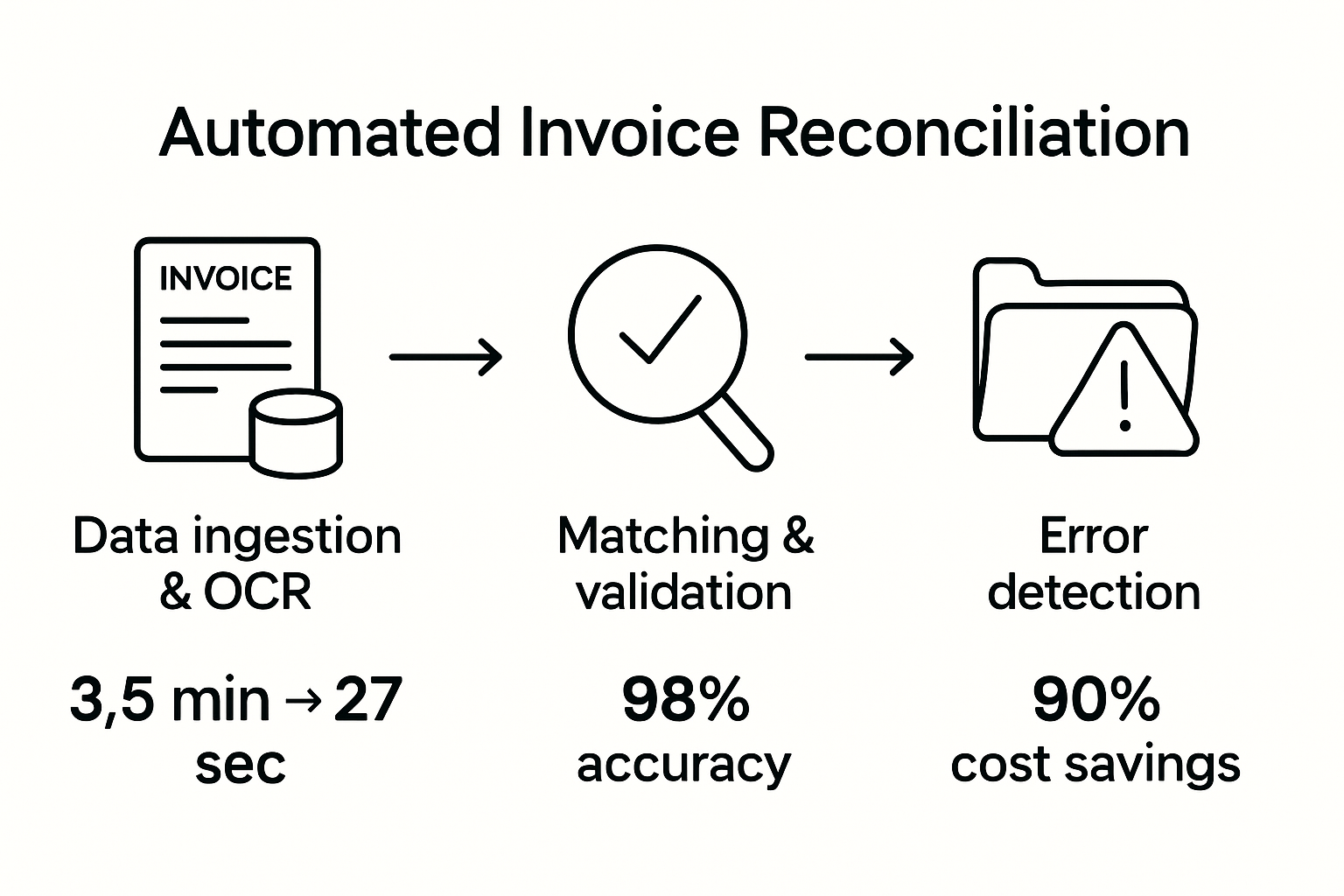Automating invoice reconciliation once sounded out of reach for most small businesses and finance teams. Now automated systems can process an invoice in less than 27 seconds and deliver up to 98 percent accuracy, changing everything about how companies handle payments. Most people imagine data entry as tedious and error-prone, but technology is flipping that script. Instead of fighting with endless spreadsheets, finance teams are now getting real-time insights and nearly error-free reports with a single click.

Automated Invoice Reconciliation: Save Time and Reduce Errors
Table of Contents
- How Automated Invoice Reconciliation Works
- Key Benefits For Finance Teams And SMBs
- Common Challenges And How To Overcome Them
- Best Practices For Successful Implementation
Quick Summary
| Takeaway | Explanation |
|---|---|
| Automate Invoicing to Save Time | Automated systems reduce invoice processing from 3.5 minutes to under 27 seconds, enhancing efficiency. |
| Achieve 98% Accuracy with AI | AI technology ensures almost perfect data extraction, minimizing human errors that can impact finances. |
| Enhance Financial Insights in Real-Time | Automated systems provide instant reporting, enabling better decision-making and financial strategy planning. |
| Address Integration Challenges Early | Conduct a thorough assessment of existing systems to ensure compatibility with new automation tools. |
| Emphasize Continuous Training for Success | Ongoing user support and training are critical to maximize adoption and efficiency in new technologies. |
How Automated Invoice Reconciliation Works
Automated invoice reconciliation transforms traditional financial processes by leveraging advanced technologies to streamline complex accounting tasks. This sophisticated approach eliminates manual data entry, reduces human error, and accelerates financial workflows with precision and efficiency.
Intelligent Data Extraction Techniques
At the core of automated invoice reconciliation are powerful AI and machine learning algorithms designed to capture and process invoice information rapidly. Explore our advanced data processing guide to understand how these technologies work. According to research from a leading technology journal, AI technologies can reduce invoice processing times from over three and a half minutes to less than 27 seconds per invoice, achieving up to 98% accuracy in data extraction and validation.
The process begins with sophisticated optical character recognition (OCR) technology that scans and digitizes invoice documents. These advanced systems can handle multiple document formats including PDFs, images, and scanned paper invoices. Machine learning algorithms then analyze the extracted text, identifying critical information such as vendor names, invoice numbers, line items, tax details, and total amounts with remarkable precision.
Automated Matching and Validation
Once data is extracted, the system performs complex validation and matching processes. According to a detailed study from Taiwan’s medical research center, automated reconciliation software can cross-reference invoice data against multiple internal systems and databases in real time. This means comparing vendor invoices with purchase orders, contract terms, and existing financial records to detect any discrepancies instantly.
The automation goes beyond simple data matching. Advanced AI algorithms can flag potential issues such as duplicate invoices, pricing inconsistencies, or unauthorized expenses. By implementing intelligent rule-based checks, businesses can prevent financial errors before they become significant problems. Research indicates that this approach can decrease invoice processing expenses by up to 90%, allowing organizations to reallocate resources more strategically.
Real-Time Reporting and Integration
Modern automated invoice reconciliation systems provide comprehensive reporting and seamless integration capabilities. They can automatically export validated data to accounting software, enterprise resource planning (ERP) systems, and financial management tools. This eliminates manual data transfer, reduces the risk of human error, and ensures consistent, accurate financial records across different platforms.
The entire reconciliation process happens within minutes, transforming what traditionally took hours or days into a swift, accurate workflow. By removing manual intervention, businesses can significantly reduce processing times, minimize errors, and gain real-time insights into their financial transactions.
To help visualize the time savings and accuracy improvements offered by automated invoice reconciliation, here’s a table summarizing key statistics mentioned in the article:
| Metric | Manual Process | Automated Process |
|---|---|---|
| Invoice Processing Time (per invoice) | 3.5 minutes | < 27 seconds |
| Data Extraction and Validation Accuracy | Varies (often lower) | Up to 98% |
| Reduction in Processing Expenses | N/A | Up to 90% saved |

Key Benefits for Finance Teams and SMBs
Automated invoice reconciliation delivers transformative advantages for finance teams and small to medium businesses, revolutionizing traditional financial management approaches. By implementing intelligent technology, organizations can unlock significant operational improvements and strategic benefits.
Cost and Time Efficiency
Financial teams spend considerable time manually processing and reconciling invoices. Discover our comprehensive billing data insights to understand the potential savings. According to a comprehensive financial technology report, businesses can reduce invoice processing expenses by up to 90% through automation. The average manual invoice processing takes 3.5 minutes per document, while AI-driven systems complete the same task in less than 27 seconds.
The time savings are substantial. By eliminating repetitive manual tasks, finance professionals can redirect their efforts towards strategic financial planning, analysis, and decision-making. Small businesses, often constrained by limited resources, can particularly benefit from this efficiency, allowing their finance teams to focus on growth-oriented activities rather than administrative work.
Error Reduction and Financial Accuracy
Manual invoice processing is inherently prone to human errors. Mistyped numbers, overlooked discrepancies, and data entry mistakes can lead to significant financial complications. Automated invoice reconciliation provides a robust solution with unprecedented accuracy. Research indicates that AI-powered systems achieve up to 98% data extraction and validation accuracy, dramatically reducing the risk of financial errors.
These systems implement sophisticated cross-referencing mechanisms that instantly detect potential issues such as duplicate invoices, pricing inconsistencies, and unauthorized expenses. By establishing intelligent rule-based checks, businesses can prevent financial discrepancies before they escalate into costly problems. This proactive approach not only saves money but also enhances overall financial integrity and compliance.
Enhanced Financial Visibility and Strategic Insights
Beyond immediate operational benefits, automated invoice reconciliation provides unprecedented financial transparency. These advanced systems generate real-time reports and analytics, offering finance teams comprehensive insights into spending patterns, vendor performance, and cash flow dynamics. Small businesses can leverage these insights to make data-driven decisions, negotiate better vendor contracts, and optimize their financial strategies.
The integration capabilities of modern reconciliation platforms allow seamless data transfer across accounting software, ERP systems, and financial management tools. This interconnected approach ensures consistent, accurate financial records and enables more sophisticated financial planning. For SMBs competing in complex market environments, such technological capabilities can provide a significant competitive advantage, transforming financial management from a cost center to a strategic asset.

Common Challenges and How to Overcome Them
Automated invoice reconciliation offers tremendous benefits, but organizations frequently encounter specific challenges during implementation. Understanding these potential obstacles and developing strategic approaches can ensure smooth technological adoption and maximize the potential of automated financial systems.
Data Integration and Compatibility Issues
One of the most significant challenges businesses face is integrating automated invoice reconciliation systems with existing financial infrastructure. According to the U.S. Government Accountability Office financial management report, complex data integration can create substantial operational barriers. Check our comprehensive invoice automation guide for practical strategies.
Companies often struggle with connecting new automated systems to legacy accounting software, enterprise resource planning (ERP) platforms, and other financial management tools. These compatibility issues can result in data silos, incomplete information transfer, and reduced system effectiveness. To overcome this challenge, businesses should:
- Prioritize platforms with robust API integration capabilities
- Conduct thorough system compatibility assessments before implementation
- Consider middleware solutions that facilitate smoother data translation
- Work closely with technology vendors to develop custom integration pathways
Data Quality and Standardization
Another critical challenge is maintaining high-quality, standardized data across diverse invoice formats and sources. Invoices arrive in multiple formats including PDFs, images, scanned documents, and digital files, each presenting unique extraction complexities. Inconsistent data formatting can compromise the accuracy of automated reconciliation processes.
Addressing data quality requires a multifaceted approach:
- Implement advanced machine learning algorithms capable of handling varied document structures
- Develop comprehensive data validation rules
- Create standardized templates and guidelines for invoice submissions
- Regularly audit and clean existing financial data repositories
Change Management and User Adoption
Technological implementation is as much about human factors as it is about software capabilities. Resistance to change and lack of user understanding can significantly hinder the successful adoption of automated invoice reconciliation systems. Finance teams accustomed to traditional manual processes may feel uncertain about new technologies.
Successful change management involves:
- Providing comprehensive training programs
- Demonstrating clear productivity and accuracy benefits
- Encouraging gradual system adoption
- Creating feedback mechanisms for continuous improvement
- Highlighting how automation enhances rather than replaces human expertise
By anticipating these challenges and developing strategic approaches, organizations can successfully navigate the transition to automated invoice reconciliation. The key lies in comprehensive planning, continuous learning, and maintaining a flexible technological ecosystem that adapts to evolving business needs.
Here is a summary checklist table outlining common challenges in automated invoice reconciliation and practical ways to overcome them, as described in the article:
| Challenge | Description | Solutions/Recommendations |
|---|---|---|
| Data Integration & Compatibility | Difficulty connecting automation tools with existing systems | Use APIs, assess compatibility, consider middleware, collaborate with vendors |
| Data Quality & Standardization | Inconsistent formats impact data accuracy | Use ML algorithms, set validation rules, standardize templates, audit data |
| Change Management & User Adoption | Resistance to new workflows among finance teams | Provide training, highlight benefits, phased adoption, feedback channels |
Best Practices for Successful Implementation
Successful implementation of automated invoice reconciliation requires strategic planning, thoughtful execution, and a comprehensive approach that addresses technological, operational, and human factors. Organizations must navigate this transformation carefully to maximize the potential of their new financial systems.
Comprehensive System Assessment and Planning
Before implementing automated invoice reconciliation, businesses must conduct a thorough system assessment. According to the U.S. Government Accountability Office financial management guidelines, establishing clear operational procedures is crucial for successful automation. Learn more about invoice upload strategies to streamline your implementation process.
Key planning steps include:
- Mapping existing financial workflows and identifying potential integration points
- Evaluating current software infrastructure and compatibility
- Determining specific organizational reconciliation requirements
- Creating a detailed implementation roadmap with measurable milestones
- Budgeting for potential customization and training expenses
This preparatory phase helps organizations anticipate potential challenges and develop targeted strategies for smooth technological adoption.
Data Validation and Quality Management
Data integrity stands as a critical component of successful automated invoice reconciliation. Research from the National Institutes of Health emphasizes the importance of establishing robust data validation protocols. Organizations must implement comprehensive strategies to ensure accuracy and reliability throughout the reconciliation process.
Effective data quality management involves:
- Developing standardized data input and validation rules
- Creating comprehensive documentation for data processing
- Implementing regular system audits and quality checks
- Establishing clear protocols for handling exceptional cases
- Maintaining flexible validation mechanisms that adapt to evolving business needs
By prioritizing data quality, businesses can maximize the accuracy and reliability of their automated reconciliation systems.
Continuous Training and User Engagement
Technological implementation extends beyond software installation. Successful adoption requires ongoing training, user support, and a culture of continuous learning. Organizations must invest in comprehensive training programs that help finance teams understand and embrace new technological capabilities.
Key strategies for user engagement include:
- Developing multi-level training programs catering to different skill levels
- Creating user feedback mechanisms
- Providing ongoing technical support and resources
- Encouraging a culture of technological curiosity and adaptability
- Recognizing and rewarding team members who successfully adopt new technologies
By treating technological implementation as a collaborative journey, businesses can transform potential resistance into enthusiastic acceptance. The goal is not just to implement a new system but to empower finance teams with tools that enhance their strategic capabilities.
Successful automated invoice reconciliation implementation requires a holistic approach that balances technological innovation with human expertise. Organizations that approach this transformation strategically will unlock significant operational efficiencies and competitive advantages.
Frequently Asked Questions
How does automated invoice reconciliation work?
Automated invoice reconciliation uses advanced technologies like AI and machine learning to capture, process, and validate invoice data quickly. The system can scan various document formats, extract relevant information, and automatically match it against internal records in real time.
What are the main benefits of implementing automated invoice reconciliation?
The key benefits include significant time savings, with invoice processing reduced from over 3.5 minutes to less than 27 seconds, increased data accuracy with up to 98% accuracy, enhanced financial visibility through real-time reporting, and streamlined workflows that allow finance teams to focus on strategic activities.
What challenges might companies face during the implementation of automated invoice reconciliation?
Common challenges include data integration issues with existing financial systems, maintaining high data quality and standardization across diverse invoice formats, and managing change to ensure user adoption of new technologies. Addressing these challenges requires careful planning and ongoing support.
How can businesses ensure successful adoption of automated invoice reconciliation systems?
To ensure successful adoption, businesses should provide comprehensive training for employees, demonstrate the productivity benefits of the new system, create phased implementation strategies, and establish feedback mechanisms for continuous improvement. Engaging users helps build a positive culture around the technology.
Ready to Eliminate Invoice Errors and Free Up Hours Every Week?
Manual invoice reconciliation is frustrating. Errors slip in easily. Time drains away as teams type the same information over and over. The article explained how error reduction and real-time insights are now possible with intelligent automation. If you are tired of fighting messy spreadsheets or are worried about financial data accuracy, there is a better way.

Level up your workflow with Invoice Parse, the AI-powered platform made to process your invoices in seconds. Upload any PDF or image invoice—get structured data extracted accurately, no templates needed. Export your instant results directly to Excel, Power BI, or your favorite workflow tools. Businesses who want to unlock cost and time savings can get started by exploring our automation features and subscription plans. Experience invoice reconciliation made easy. Sign up now and take control of your financial process before another month slips by.
